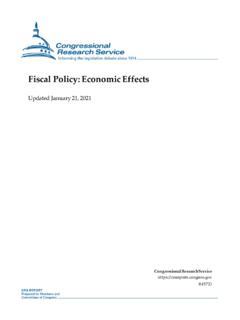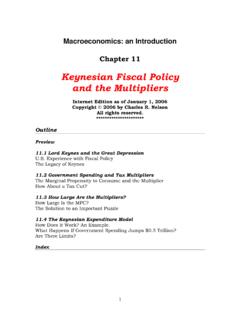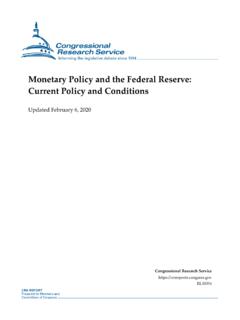Transcription of Fiscal policy, public debt management and government …
1 Fiscal policy , public debt management and government bond markets: the case for the Philippines Diwa C Guinigundo1. Abstract The Fiscal health of the Philippines has improved significantly over the past decade. Notwithstanding the dividends from reforms, challenges remain for the Philippines on the Fiscal side. policy coordination, primarily through the Development Budget Coordinating Committee, has helped to reduce the need for policy sterilisation. However, some concerns have been raised by the Bangko Sentral ng Pilipinas (BSP) about the reduced issuance of government securities as well as possible interest rate repression.
2 Meanwhile, sufficient liquidity in the domestic economy has ensured that the crowding out of private offerings is not an immediate concern. Further reforms on public debt management are needed to promote efficiency, further develop the capital market and enhance overall financial stability. Keywords: Fiscal policy , public debt management , Philippines JEL classification: E630, H063. 1. Deputy Governor, monetary Stability Sector, Bangko Sentral ng Pilipinas BIS Papers No 67 269. 1. Introduction The Fiscal health of the Philippines has improved significantly over the past decade.
3 By 2005, there was widespread recognition that the Fiscal position of the national government had become untenable. Subsequently, Fiscal prudence was observed and new taxes were enacted. As a quick result, the Fiscal position had almost returned to balance by 2007. This led to a reduction in the total outstanding government debt from a high of of GDP in 2004 to a more manageable of GDP by 2010. Along with improved Fiscal balance numbers and relatively robust economic performance, the Philippines has earned credit rating upgrades and expects to do more in the near future.
4 In recognition of the country's sustainable Fiscal position, debt spreads have narrowed to levels better than those of higher- rated sovereign bond issuers. Notwithstanding the dividends from reforms, challenges remain for the Philippines on the Fiscal side. Weak revenue generation, enactment of revenue-eroding measures by the Philippine Congress and recent underspending have generated concerns for the Fiscal authorities. While revenue shortfalls have been manageable, they may contribute to rising deficits in the future.
5 Should the Fiscal stance become unsustainable, public expenditure may again be constrained with a corresponding negative effect on economic growth. With the improvement in the scale of government debt , the debt service burden has also become less of a Fiscal drag. From 85% of total government revenue in 2004, the debt ratio fell to 57% by 2010. As a proportion of GDP, the debt service burden likewise dropped to % in 2010 from a high of in 2006. While the Fiscal situation is currently under control, the prospect of either lost opportunities for improved economic performance or future instability requires further thought.
6 2. Potential for constraints on monetary policy from an unsustainable path for public debt Measurement of the Fiscal policy stance and public debt As determined by the Fiscal authorities, the Fiscal policy stance is designed to deliver sound public financing including a commitment to medium-term objectives2 combined with the flexibility to respond to changing economic conditions in the short term. Its measurement takes into consideration cyclical movements in the economy and contingent liabilities over the medium term. By cyclically adjusting the Fiscal policy stance, important Fiscal variables are scaled to GDP to provide some insight into cyclical patterns in the economy.
7 Notwithstanding these measures, impulse responses generated from a vector error correction model (VECM)3 show that public spending has been cyclical and needs to adopt a more countercyclical stance to support the economy against countercyclical spending shocks (Figure 1). 2. The medium-term goals of the Fiscal programme pertain to Fiscal consolidation with a view to meeting a targeted ratio of the Fiscal deficit to GDP. 3. The VEC model examines the impact of policy measures adopted during the global financial crisis. monetary policy was proxied by M3 in real terms while Fiscal policy was represented by government consumption.
8 The VEC model is taken from Redoblado (2011). Please see Annex A for details. 270 BIS Papers No 67. Figure 1. Response of national government expenditure to a GDP shock .06..05. Gross Domestic Product Expenditures by the National government .04..03..02..01..00. 1 2 3 4 5 6 7 8 9 10. public debt measures used in formulating the Fiscal stance cover the Local government Units (LGU), the 14 monitored government Owned and/or Controlled Corporations (GOCCs), two government Financial Institutions (GFIs), and three Social Security Institutions.
9 Through the government 's Fiscal risk management programme, contingent liabilities relating to pensions and health care spending are included in the medium-term Fiscal programme. These items are periodically monitored but do not form part of the Fiscal budget until assumed by the government . The government 's gross debt is measured by netting out deposits placed with the central bank. However, in the presentation of the consolidated public sector debt , the intra-sector debt holdings are netted out. With respect to the measurement of public sector assets when formulating the Fiscal stance, these assets (eg central bank assets, state pension funds) are not seen as an offset to gross debt .
10 Otherwise, the ratio of debt to assets would effectively be lower. The Fiscal authorities, through the Development Budget Coordinating Committee (DBCC), set Fiscal targets such as the key tax and spending priorities while avoiding an unsustainable rise in the burden of public debt . Interaction between monetary and Fiscal policy Results from the same model suggest that the BSP and the national government have coordinated their policy actions so that policy sterilisation has been avoided. Both impulse response analysis and variance decomposition show that shocks to domestic liquidity allow for higher spending by Fiscal authorities.















